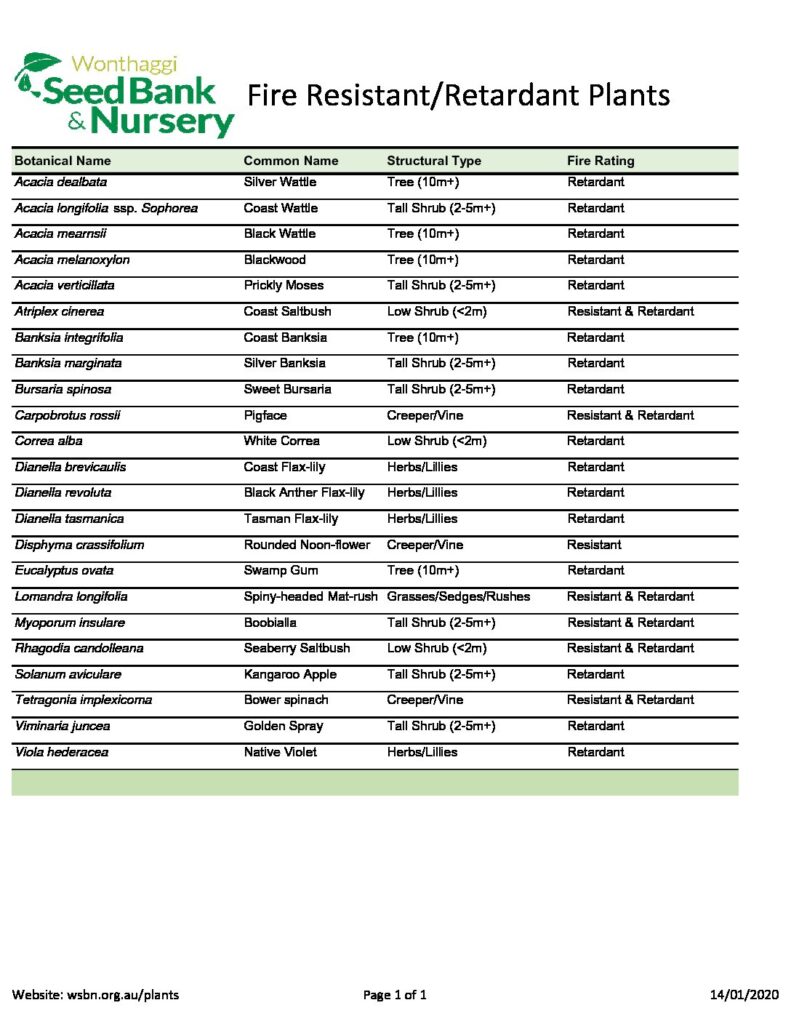This page is in memory of Forest Fire Management Victoria (FFMV) firefighter & Parks Victoria staff member Bill Slade on active duty in East Gippsland on 11 January 2020.
Bill was a highly regarded member of the Wonthaggi community and will be greatly missed by us all.
Careful plant selection can have a significant impact on the bushfire risk to your home.
When plants are selected, located and maintained appropriately :
- Fire-retardant plants are capable of absorbing more radiant heat from an approaching fire without burning
- Embers and sparks can be trapped and wind speed reduced by fire retardant trees and other plants near a house
- Fire retardant ground covers can be effective as they slow the travel of a fire through the litter later
The two definitions below are attributed to the Australian Plants Society (Victoria). PLEASE NOTE: The Society include General Disclaimers and Terms and Conditions for giving this advice. Given Australia’s experience with bushfire, the General Disclaimers and Terms and Conditions is prudent advice:
- Fire Retardant Plants – Plants that will not burn in the first wave of a bushfire, but may burn once dried out.
- Fire Resistant Plants – Plants that will not burn in the face of continued flame.
DISCLAIMER: All plants will burn in extreme conditions. Planting fire-retardant or fire-resistant plants is no substitute for choosing to leave a high-risk bushfire area before a fire threatens. Considering fire retardant and/or fire-resistant plants is just one part of your Fire Protection Plan. You MUST seek advice and DO NOT RELY on a vegetation plan to be your ONLY Fire Plan. It is your responsibility to assess and verify the accuracy, completeness, and reliability of the information on this website and to seek professional advice where necessary. This is especially important if you live in a bushfire prone environment.
Fire Retardant Plants
- Acacia dealbata
- Acacia longifolia ssp. sophorae
- Acacia mearnsii
- Acacia melanoxylon
- Allocasuarina verticillata
- Atriplex cinerea
- Banksia integrifolia
- Banksia marginata
- Bursaria spinosa
- Carpobrotus rossii
- Correa alba
- Dianella brevicaulis
- Dianella revoluta
- Dianella tasmanica
- Goodenia ovata
- Lomandra longifolia
- Myoporum insulare
- Rhagodia candolleana
- Senecio pinnatifolius
- Solanum aviculare
- Tetragonia implexicoma
- Viminaria juncea
- Viola hederacea
Fire Resistant Plants
- Atriplex cinerea
- Carpobrotus rossii
- Disphyma crassifolium
- Lomandra longifolia
- Myoporum insulare
- Rhagodia candolleana
- Tetragonia implexicoma
References that have assisted WSBN in classifying plants that we propagate as either ‘Fire Retardant’ or ‘Fire Resistant’ include:
- Australian Native Plants Society (Australia)
- Australian Plants Society Victoria
- State Government Victoria – Landscaping for bushfire prone areas
- Government of South Australia – Fire Resistant Plants
- Grow What Where – 1990 edition

